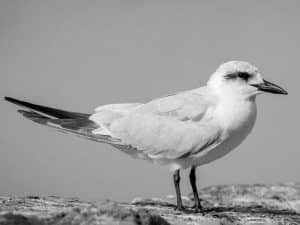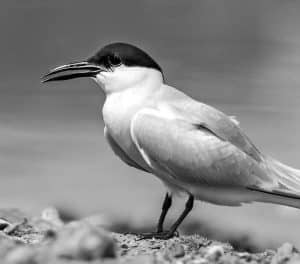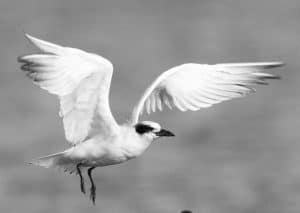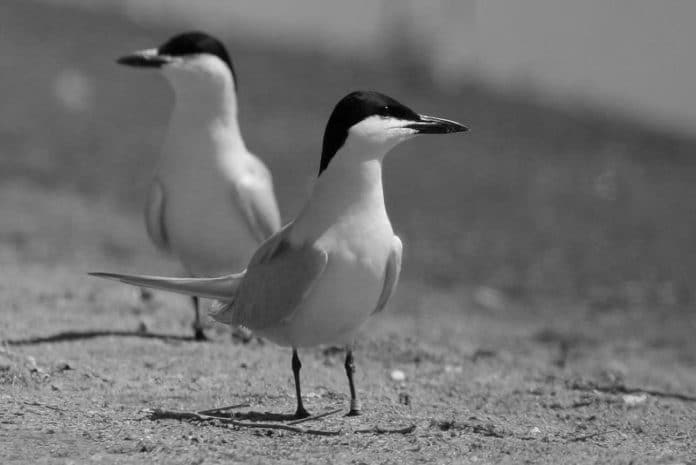Introduction to the Gull-Billed Tern
The Gull-Billed Tern is a fascinating bird species that can be found in Tanzania, along the African coast. These elegant birds are known for their distinct appearance and behavior, making them a delight to observe in their natural habitat. In this article, we will explore the habitat, distribution, behavior, and conservation status of the Gull-Billed Tern in Tanzania, as well as the importance of wetlands for this species and other bird species found in Tanzanian wetlands.
Habitat and Distribution of the Gull-Billed Tern in Tanzania

The Gull-Billed Tern is commonly found in coastal areas, including estuaries, lagoons, and salt pans. These birds are particularly attracted to wetlands with a mix of mudflats, sandy shores, and shallow water, as these habitats offer abundant food sources. In Tanzania, the Gull-Billed Tern can be spotted along the coast, including areas such as Pangani Bay, Dar es Salaam, and the Rufiji Delta.
The distribution of the Gull-Billed Tern extends beyond Tanzania, with populations found throughout Africa, Europe, and Asia. However, the African coast, including Tanzania, is a significant breeding and wintering ground for these birds. During the breeding season, they can be found nesting in colonies on sandy islands and coastal marshes.
Behavior and Characteristics of the Gull-Billed Tern
The Gull-Billed Tern is a medium-sized bird with a distinct appearance. It has a black cap and a black bill, which sets it apart from other tern species. Its plumage is predominantly white, with gray wings and a forked tail. These birds are known for their graceful flight and agile diving abilities.
In terms of behavior, the Gull-Billed Tern is a highly skilled hunter. It feeds primarily on small fish, crustaceans, and insects, which it catches by plunge-diving into the water from mid-flight. The Gull-Billed Tern is also an opportunistic feeder, and it can be seen scavenging on carrion or stealing food from other birds.
Conservation Status of the Gull-Billed Tern in Tanzania
The Gull-Billed Tern is currently listed as a species of least concern on the IUCN Red List. However, it is important to note that the conservation status can vary regionally. In Tanzania, the Gull-Billed Tern faces several threats, including habitat loss, disturbance from human activities, and pollution of coastal waters.
Efforts are being made to protect the Gull-Billed Tern and its habitat in Tanzania. Conservation organizations and local communities are working together to establish protected areas and raise awareness about the importance of preserving coastal ecosystems. These initiatives are crucial for ensuring the long-term survival of the Gull-Billed Tern and other bird species that rely on wetlands.
The Importance of Wetlands for the Gull-Billed Tern

Wetlands play a vital role in the life cycle of the Gull-Billed Tern. These birds depend on wetlands for nesting, feeding, and resting during migration. Wetlands provide a diverse range of food sources, including fish, crustaceans, and insects, which are essential for the survival of the Gull-Billed Tern and its offspring.
In addition to providing food, wetlands also offer suitable nesting sites for the Gull-Billed Tern. The sandy islands and coastal marshes found in Tanzanian wetlands provide a safe and secure environment for breeding. The availability of suitable nesting habitat is crucial for maintaining healthy populations of the Gull-Billed Tern in Tanzania.
Other Bird Species Found in Tanzanian Wetlands
Tanzanian wetlands are not only home to the Gull-Billed Tern but also host a diverse array of bird species. These wetlands provide important stopover points for migratory birds, making them hotspots for birdwatching and bird photography. Some of the other bird species that can be found in Tanzanian wetlands include the African Fish Eagle, the Greater Flamingo, the African Jacana, and the Malachite Kingfisher.
Birdwatchers and nature enthusiasts visiting Tanzanian wetlands will have the opportunity to observe and appreciate the rich avian biodiversity that these habitats support. The combination of diverse bird species and stunning natural landscapes makes Tanzanian wetlands a must-visit destination for bird lovers.
Best Places to Spot Gull-Billed Terns in Tanzania
If you’re interested in spotting Gull-Billed Terns in Tanzania, there are several locations that offer excellent opportunities for birdwatching. Pangani Bay, located on the northern Tanzanian coast, is known as a prime spot for observing these birds. The bay’s diverse habitats, including mangroves, mudflats, and sandbars, attract a variety of bird species, including the Gull-Billed Tern.
Another great location for spotting Gull-Billed Terns is the Rufiji Delta, a vast wetland complex in southern Tanzania. The delta is home to a wide range of bird species, and Gull-Billed Terns can often be seen nesting and foraging in this area. Dar es Salaam, Tanzania’s largest city, also offers opportunities for spotting these beautiful birds along its coastal areas.
Tips for Birdwatching and Photographing Gull-Billed Terns

If you’re planning to go birdwatching or photographing Gull-Billed Terns in Tanzania, there are a few tips that can enhance your experience. Firstly, it’s important to bring binoculars or a spotting scope to get a closer look at these birds. The Gull-Billed Terns can sometimes be found in large flocks, so having the right equipment will allow you to observe their behavior and characteristics in more detail.
Secondly, it’s best to visit wetlands during the early morning or late afternoon when bird activity is at its peak. The soft golden light during these times of the day can also add a beautiful touch to your photographs. Patience is key when birdwatching, as these birds can be quite elusive. Take your time to observe their movements and wait for the perfect moment to capture their graceful flight or feeding behavior.
Conservation Efforts for the Gull-Billed Tern in Tanzania
Conservation efforts for the Gull-Billed Tern in Tanzania are ongoing. Local and international organizations are working together to protect the species and its habitat. These efforts include the establishment of protected areas, the implementation of sustainable fishing practices, and the promotion of responsible tourism in wetland areas.
By supporting these conservation initiatives, individuals can contribute to the preservation of the Gull-Billed Tern and its wetland habitats. Choosing eco-friendly travel options, spreading awareness about the importance of wetlands, and respecting the natural environment when visiting these areas are all ways to make a positive impact.
Conclusion
The Gull-Billed Tern is a remarkable bird species that adds to the biodiversity and natural beauty of Tanzania’s wetlands. Its unique appearance, graceful flight, and agile hunting techniques make it a captivating subject for birdwatchers and photographers. By understanding the habitat, behavior, and conservation status of the Gull-Billed Tern, we can appreciate the importance of protecting these wetland marvels along the African coast. So, grab your binoculars and camera, and embark on an unforgettable journey to spot the Gull-Billed Tern in Tanzania’s stunning wetlands.


































